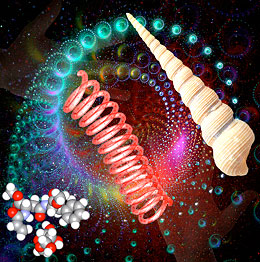キラリティー応答性ポリマーを用いてキラル信号を巨視的材料特性に変換する
Potential role of LMP2 as tumor-suppressor defines new targets for uterine leiomyosarcoma therapy.
2012年1月18日 NPG Asia Materials 4, e4 (2012) doi:10.1038/am.2012.6
スマート材料: ひねって特性を変える

キラリティーとは、右手と左手や、右巻きらせんと左巻きらせんのように、鏡像どうしを重ね合わすことができない性質(対掌性)のことである。キラリティーは、化学や生物学において重要な概念であり、キラル分子の対掌性を変えることによって特性に大きな影響が及ぶ。今回、Guangyan QingとTaolei Sunは、どうすればキラル応答性ポリマーが分子レベルから巨視的レベルまで信号を伝達できるかについて概説している。利用可能な方法としては、キラルユニットを刺激応答性ポリマー構造に組み込む方法と、ポリマーとキラル分子との相互作用を変化させる方法の2つがある。化学的信号や熱的信号といった特定要因がこれらの系のキラリティーを変え、さらには、巨大分子特性や材料特性に影響を及ぼすのだ。この過程を利用すれば、センシングやエレクトロニクス応用向けの機能性デバイスを構築したり、もともとキラリティーを持つ生体分子系のコンフォメーションもコントロール可能になるだろう。
Smart materials: A handy twist in properties
Chirality – the ‘handedness’ of entities whose mirror images of each other are not superimposable, such as our left and right hands, or helices that twist in opposite directions – is a crucial concept in chemistry and biology: changing the handedness of chiral molecules has a profound impact on their properties. Guangyan Qing and Taolei Sun review how chiral-responsive polymers can convey a signal from the molecular to the macroscopic level. Two strategies can be adopted: incorporating chiral units into the structure of stimuli-responsive polymers, or altering interactions between polymers and chiral molecules. Specific triggers, such as chemical or thermal signals, alter the chirality of these systems, which in turn affect their macromolecular and materials properties. This can be exploited to construct functional devices, such as for sensing or electronic applications, and to control the conformation of inherently chiral biosystems.

